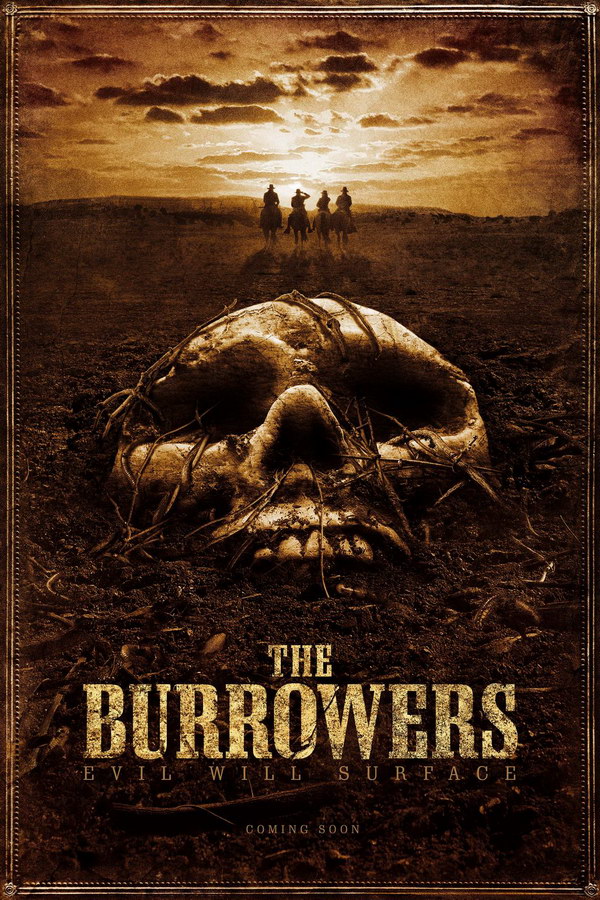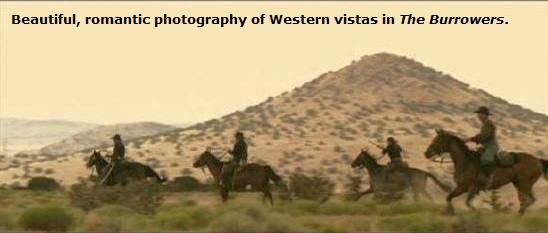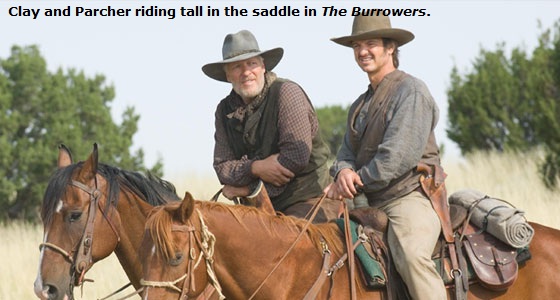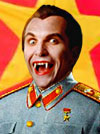|
MENU
Home
Books
Horror Film Aesthetics
Horror Film Festivals and Awards
Vampire
Nation
Pentagon Possessed
Cost of Freedom
Manhattan
Sharks
Halloween
Candy
Hollywood
Witches
Short Works
Pursuits
Actor
Film Festival Director
Editorial Services
Media
Appearances
Horror Film Reviews
Blogs
Horror Film Aesthetics
Communist Vampires
Horror Film Festivals and Awards
Other
Business
Satire
Nicolae Ceausescu
Commuist Vampires
Stalinist Zombies
L'Internationale Song
Links

|
The Burrowers (2008, director:
J.T. Petty; script:
J.T. Petty;
cast: Clancy Brown, David Busse, Harley Coriz)
 The “horror western” is a subgenre of the horror genre, not
the Western. The horror western uses Western icons
(e.g.,
Grim Prairie Tales), but its story conventions and
atmosphere are horror. It is marketed toward -- and attracts
-- horror fans, not Western fans. The “horror western” is a subgenre of the horror genre, not
the Western. The horror western uses Western icons
(e.g.,
Grim Prairie Tales), but its story conventions and
atmosphere are horror. It is marketed toward -- and attracts
-- horror fans, not Western fans.
Horror westerns normally mix these two genres from the
start. We see the Western icons (the period locale, cowboys,
Indians. etc.), but the story is soon, and clearly, horror.
The Burrowers is set in the Dakota Territories, 1879. But
rather than blend the Western and horror genres,
The Burrowers's strength is that it begins largely as
an authentic Western. Only after the audience is emotionally
adjusted to a Western does
The Burrowers become a horror film.
The Burrowers opens on a romantic conversation, set on an
idyllic Western ranch, a golden sunset in the background.
Coffey with Maryanne, as they discuss how he will ask her
father for her hand in marriage.
Minutes later, the first violent outbreak is typical of
Westerns -- we hear gunfire outside the cabin. The family
escapes to a cellar. They hear strange noises -- our
first hint of an
unnatural threat, as required by horror -- but we don't
see any
unnatural threats.
The family is killed. Maryanne is apparently kidnapped by
Indians. (Audiences know it wasn't Indians -- but are lulled
into believing that Maryanne may still be alive.)
For the next 44-45 minutes,
The Burrowers is mostly a straight Western. Romantic
photography, charging horses, beautiful prairie vistas --
supported by appropriate Western period music.

Psychologically, emotionally, dramatically, the characters are
typically Western. The strong and silent Clay (very much a
The Searchers, John Wayne type). The gentlemanly
gunslinger Mr. Parcher. Coffey, the romantic Irish immigrant,
riding to rescue Maryanne. Callaghan, the “noble Negro” (what
Spike Lee calls the "magical
Negro") -- compassionate, honorable, enduring racism
without ever losing his dignity.

There is also an arrogant U.S. Cavalry officer, callous and
cruel to both blacks and Indians. When he threatens to whip
Coffey for “feeding my Indian,” the strong and silent Clay
stares him down, ready for a gunfight, though outnumbered by
the officers' troops.
Naturally, the officer backs down from the heroic Clay.
Throughout these first 44-45 minutes, there are intimations
of horror -- the strange scars on a dead girl's neck;
strange holes in the ground; something in the bushes that
kills four troops. But overwhelmingly,
The Burrowers's mise-en-scène, music, story, characters,
and themes (loyalty toward loved ones and comrades; dignity in
the face of adversity) are those of a Western.
The film emotionally conditions the audience for
Western. Even if they know intellectually that they're
watching a horror film, they feel like they're watching
a Western. This conditions their expectations for a Western
outcome. They anticipate (even if only subconsciously) that
Coffey will rescue Maryanne. Most of the heroes will survive
-- and if any should die, they will die noble, honorable,
courageous deaths.
Yet as the film progresses,
The Burrowers morphs from a Western into a horror film.
Midway into the film, Clay is killed. It's not an honorable
death, but shocking and brutal. He dies not like John Wayne,
giving a noble speech while heroically fading away, but is
unceremoniously butchered like one of
Leatherface's victims.

Clay's death is emotionally jarring. I regard this as the
event that pushes the audience's mindset out of the Western
genre, and into horror.
Things worsen. The monsters (vampiric “burrowers” living
underground) reveal themselves. The
unnatural threat becomes clear and visible.
The burrowers' bite poisons Parcher. As he fades over the
course of the next day and night, he grows paranoid and
cowardly. He shoots at his former comrades, lest they desert
him.
In the end, he dies a coward's death. (His emotionally selfish
state of mind is not unlike the cowardly jock in
Jeepers Creepers 2 who wanted to abandon the weak ones,
only to be killed himself.)
Callaghan likewise dies a senseless, ignoble death, the
result of cowardice and incompetence. A victim of friendly
fire, and an incompetent army surgeon (who perhaps callously
amputated Callahan's leg, not much caring about a mere Negro's
health). Callaghan, the “noble Negro,” dies like a piece of
meat -- discarded like an anonymous victim in a slasher film.
Some friendly Indians die senseless deaths too, mistaken by
the army as hostiles and executed. Much like Ben was mistaken
for a zombie in
Night of the Living Dead, and thus killed by a sheriff's
posse. In horror films, innocents often die at the hands of
incompetent authority figures.
Coffey fails to rescue Maryanne, or anyone else. He fails to
bring proof of what he's learned about the burrowers. The
army, by killing the friendly Indians, kills any hope of
learning how to stop the burrowers. As in many horror films,
the protagonists stymie, but do not destroy, the threat.
Myers will return to kill again.

By starting as a straight Western (rather than a “horror
western”), and only morphing into horror after the audience
has been emotionally conditioned for a Western,
The Burrowers solves a common horror film problem:
Horror requires an
unnatural threat -- a sudden realization that (to quote
from Frank Lupo's
Werewolf pilot script) "The world is not as our minds
believe."
The problem is that audiences get jaded after seeing so many
horror films with the same
unnatural threat -- be it a vampires, zombies, or
uberpsychos. Familiarity breeds a sense of normalcy.
Seeing them so often, we come to feel that they're
commonplace, hence, natural.
As a result, horror filmmakers are challenged to find new ways
to "creep out" audiences with a novel
unnatural threat, some new threat that will
overturn viewers' sense of reality.
Because most horror filmmakers can't rise to the challenge,
they instead rely on gore and shocks (e.g.,
Devil's Grove).
The Burrowers solves this problem by starting as an
authentic Western. Only after the audience is
emotionally invested in a Western, with preconceived
expectations of the characters' heroic deeds and successful
fates, does the film emotionally jar them by segueing into a
horror film -- when the characters are suddenly revealed to be
cowardly and/or vulnerable.
Their deeds and deaths are typical for a horror film, but
shocking to an audience that had forgotten they were watching
a horror film.
Imagine
High Noon if, during the last third, Gary Cooper suddenly
turns cowardly, Grace Kelly is senselessly butchered like a
piece of meat, and half the town massacres the other half in
mindless mayhem.
The Burrowers demonstrates the emotional punch that comes
of establishing one genre in the audience's mind, then defying
their emotional expectations by morphing midway into
another genre. A non-horror sensibility is established,
into which any
unnatural threat feels that much more unnatural.


|






 The “horror western” is a subgenre of the horror genre, not
the Western. The horror western uses Western icons
(e.g.,
The “horror western” is a subgenre of the horror genre, not
the Western. The horror western uses Western icons
(e.g.,
